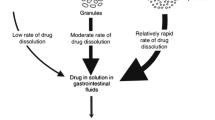Abstract
How fast can drug molecules escape from a controlled matrix-type release system? This important question is of both scientific and practical importance, as increasing emphasis is placed on design considerations that can be addressed only if the physical chemistry of drug release is better understood. In this work, this problem is studied via Monte Carlo computer simulations. The drug release is simulated as a diffusion-controlled process. Six types of Menger sponges (all having the same fractal dimension, d f = 2.727, but with different values of random walk dimension, d w ∈ [2.028, 2.998]) are employed as models of drug delivery devices with the aim of studying the consequences of matrix structural properties (characterized by d f and d w ) on drug release performance. The results obtained show that, in all cases, drug release from Menger sponges follows an anomalous behavior. Finally, the influence of the matrix structural properties on the drug release profile is quantified.
Similar content being viewed by others
References
M.J. Groves, Encyclopedia of controlled drug delivery, edited by E. Mathiowitz (Wiley & Sons, USA, 1999), p. 743.
A. Bunde, H.E. Stanley, and G.H. Weiss, J. Chem. Phys. 83, 5909 (1985).
J.D. Bonny, H. Leuenberger, Eur. J. Pharm. Biopharm. 39, 31 (1993).
M. Usteri, J.D. Bonny, and H. Leuenberger, Pharm. Acta. Helv. 65, 55 (1990).
H. Leuenberger, R. Leu, and J.D. Bonny, Drug Dev. and Ind. Pharm. 18, 723 (1992).
R. Kopelman, The fractal approach of heterogeneous chemistry, edited by D. Avnir (John Wiley & sons, Chichester, 1989) Ch. 4.
P. Costa and J.M. Sousa, Eur. J. Pharm. Sci. 13, 123 (2001).
K. Kosmidis, P. Argyrakis, and P. Macheras, J. Chem. Phys. 119, 6373 (2003).
K. Kosmidis, P. Argyrakis, and P. Macheras, Pharm. Res. 20, 988 (2003).
S. Havlin, and D. Ben-Avraham, Adv. Phys. 36, 695 (1987).
H. Leuenberger, J.D. Bonny, and M. Kolb, Int. J. Pharm. 115, 217 (1995).
S. Tarafdar, A. Franz, Ch. Schulzky, and K.H. Hoffmann, Physica A 292, 1 (2001).
Author information
Authors and Affiliations
Rights and permissions
About this article
Cite this article
Villalobos, R., Vidales, A.M., Cordero, S. et al. Monte carlo simulation of diffusion-limited drug release from finite fractal matrices. J Sol-Gel Sci Technol 37, 195–199 (2006). https://doi.org/10.1007/s10971-005-6628-8
Published:
Issue Date:
DOI: https://doi.org/10.1007/s10971-005-6628-8




